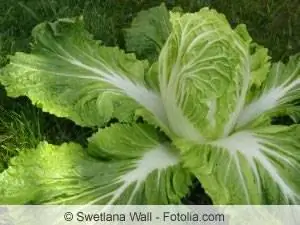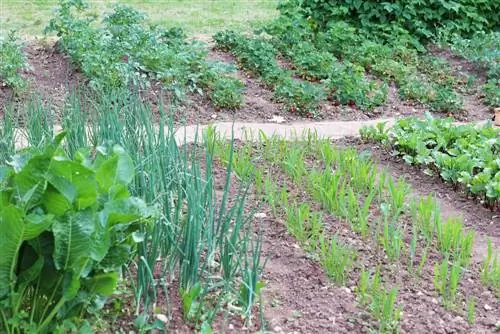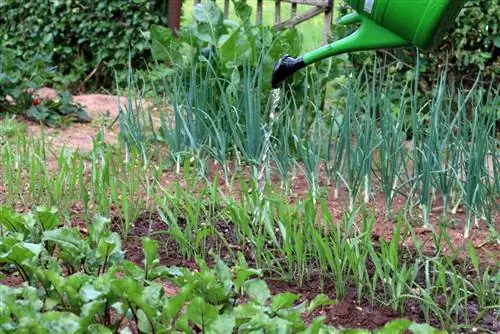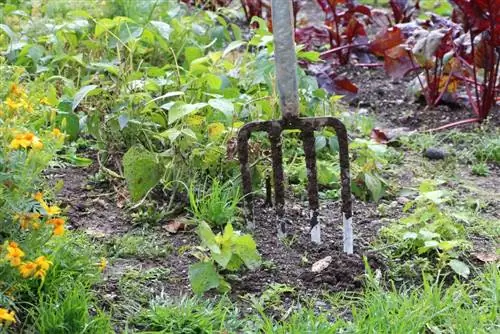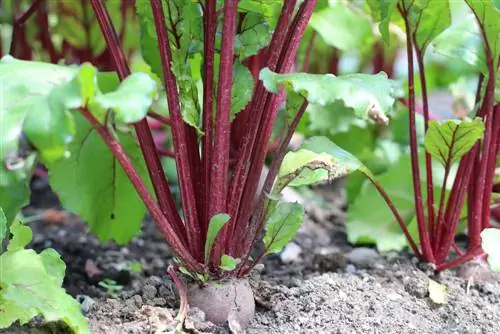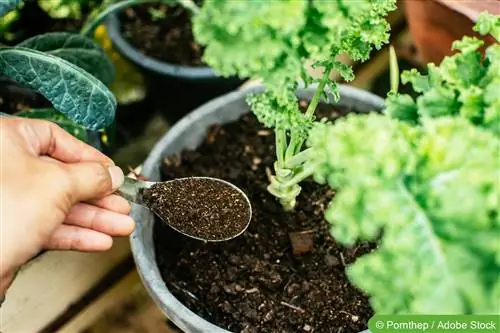- Author admin [email protected].
- Public 2023-12-17 03:39.
- Last modified 2025-06-01 06:48.
An exemplary managed ornamental and kitchen garden is based on a balanced mixed culture. Where a planting plan takes into account the nutrient requirements of the individual plants, the entire cultivation benefits from vital, magnificently flowering perennials and a bountiful vegetable harvest without depleting the soil. The highest premise for good success is knowing which category the individual plants belong to. Use the following list to get to know all the important resources for your perennial bed and vegetable garden.
List of medium feeders in the vegetable garden
The closer the plant community in the vegetable garden comes to natural conditions, the more successful the cultivation will be. In a he althy mixed culture, deep-rooted people join shallow-rooted people and heavy feeders mix with weak feeders. The following medium feeders bring the necessary balance to the bed:
Chicory (Cichorium intybus)
A medium-eater per se in the vegetable garden, it is one of the few plants that is preferred not on the windowsill, but in the cool cellar. The beet-like leafy vegetable with the delicate yellow tips only develops its rich biomass if a regular organic nutrient supply with compost and horn shavings is ensured on a weekly to bi-weekly basis.
Mixed culture recommended with carrots, lettuce and fennel
Chinese cabbage (Brassica rapa subsp. pekinensis)
While most types of cabbage are heavy eaters, Chinese cabbage has a somewhat more moderate nutrient requirement. The vegetables also score points with a comparatively short maturation time of 12 weeks. So that you can reap a rich harvest, a portion of compost is added every 2 weeks and the soil is sprinkled with highly diluted nettle manure.
Grows in harmony with runner beans, peas, summer leeks, tomatoes, endive
Endive (Cichorium endivia)
The popular curly lettuce with the loose hearts provides valuable vitamins throughout the summer. Winter varieties thrive in cold frames or manure frames during the cold season.
Goes well with cauliflower, red cabbage and Brussels sprouts
Chard (Beta vulgaris subsp. vulgaris var. vulgaris)
Very similar in preparation to spinach, hobby gardeners favor the leafy vegetable for growing at home because snails won't touch it. In addition, the plant's deep taproot loosens the soil for crop successors, such as potatoes. If chard is not harvested whole in summer, but rather leaf by leaf, fresh leaves will continue to sprout.
Good with broccoli, carrots, cauliflower, Brussels sprouts, radishes
Carrots (Daucus carota)
Essential ingredient in every vegetable garden. The planting season begins in mid-March and can continue seamlessly until June for the autumn harvest.
Good neighbors are tomatoes, peas and onions
Parsnip (Pastinaca sativa)
The classic root vegetable, also known as Germanic root, can still be found in the wild. Sown in good time from mid-March, parsnips are one of the typical autumn vegetables in the kitchen garden. The medium-eater also scores points with its robust resistance to all kinds of diseases.
Best with leek, lettuce, spinach and cucumber
Radicchio (Cichorium intybus var. foliosum)
You can see at first glance that the lettuce plant is closely related to chicory and sugar loaf. Frost-resistant down to -5 degrees Celsius, the daisy family is suitable for sowing in June/July in a second season. Housewives also value radicchio because of its long shelf life in the refrigerator for several weeks.
Compatible with fennel, carrots and lettuce
Beetroot (Beta vulgaris)
The vitamin-rich tubers grow even more nutritiously if they are regularly fertilized with comfrey and nettle manure. In addition, the medium feeder does not require any further application of fertilizer.
Grows well next to kohlrabi, cucumbers and garlic
Spinach (Spinacia oleracea)
As summer spinach, it pampers the palate with a delicate aroma and as winter spinach it provides hearty, aromatic dishes. Due to its medium nutrient requirements, experienced hobby gardeners plant spinach second only to heavy feeders.
Best neighborhood with celery, Brussels sprouts, Chinese cabbage and savoy cabbage
Black salsify (Scorzonera hispanica)
The fine root vegetables from Eurasia enrich the menu in autumn with their light, nutty taste. During the long maturation period of 28 weeks, weekly watering with nettle manure ensures the necessary nutrient supply.
Good planting partner for carrots, kohlrabi and onions
Turnip (Brassica napus)
The low-calorie root vegetables are currently experiencing a renaissance in the vegetable garden. As a medium-consuming plant, the turnip is content with 4-5 liters of compost per square meter, plus a handful of horn shavings.
Ideal for mixed cultivation with lettuce, chard, peas and spinach
Onion (Allium cepa)
They are among the all-round talents in the vegetable garden. It is only with onions that many dishes get their inimitable taste. In addition, the vegetable plant contains valuable ingredients that are used in a variety of ways in folk medicine. So that the amaryllis plant can fully develop its talents, rock dust and pure wood ash provide an organic nutrient supply. In terms of pure nitrogen requirements, the onion tends to be a weak feeder, so it is preferably planted second to heavy feeders.
Best with kale, Brussels sprouts, cauliflower, savoy cabbage, bok choy, broad beans
Tip:
Medium feeders are the ideal planting for a newly created raised bed from the second year onwards. After heavy eaters have reduced the high nutrient content to a tolerable level in the first year, the time has come for the ornamental and vegetable plants listed in this list.
List of medium feeders in the perennial bed
In order for flowering perennials to develop their beauty in the ornamental garden for many years, it is not just the light and temperature conditions that are relevant. The condition of the soil, which should be tailored to the nutrient requirements, plays an equally important role. The following medium feeders thrive vitally and he althily in nutrient-rich, humus-rich soil. They are therefore less likely to be considered for a place in a poor rock garden or gravel bed.
Mountain monkshood (Aconitum napellus)
The native ornamental perennial has been an integral part of cottage gardens for many centuries. As a medium feeder, the mountain monkshood requires regular organic fertilization every 2-3 weeks with compost.
- Growth height up to 120 cm
- For sunny to partially shaded locations
Chrysanthemum (Chrysanthemum)
Traditionally an integral part of funeral floristry and grave planting, the chrysanthemum with its wonderful varieties also beautifies the perennial bed well into autumn. If the plant finds nutrient-rich soil, it is content with compost and horn shavings every two weeks.
- Growth height 60-120 cm
- Demands many hours of sunshine
Ballbellflower (Campanula glomerata)
The perennial impresses with expressive flowers in white, pink and dark purple. In the bed it harmonizes excellently with weak, depleting ground cover plants, such as golden flax.
- Growth height 50-60 cm
- Suitable for dry locations
Montbretia (Crocosmia)
A star in perennial beds in England for decades, the elegant bulbous flower with bright red flowers is also winning the hearts of gardeners in Germany. When Montbretie is not displaying its lavish flowers, the mighty sword leaves serve as decoration.
- Growth height 80-120 cm
- Ideal for the partially shaded spot on the edge of the woods
Giant knapweed (Centaurea macrocephala)
The striking, towering flower attracts everyone's attention with artichoke-like flowers in bright yellow. Their hunger for nutrients is on the borderline between medium and heavy eaters, so fertilization every two weeks is recommended.
- Growth height up to 150 cm
- Ideal for sunny places
Yarrow (Achillea millefolium)
From the meadow yarrow as a popular medicinal plant to the wonderful varieties in enchanting colors, this medium-consuming perennial offers everything a gardener's heart desires.
- Growth height 40-70 cm
- For sunny locations
Summer Aster - Mountain Aster (Aster amellus)
In order for the robust ornamental perennial to present its magnificent flowers from July to October, it requires a medium level of nutrient supply. A weekly application of mineral-organic liquid fertilizer is recommended in the bucket.
- Growth height 40-75 cm
- For sunny, warm locations
Coneflower (Echinacea)
Thanks to its never-ending flowering period throughout the summer, the coneflower has taken perennial beds and cottage gardens by storm. If the regular supply of nutrients is ensured, the flower miracle will continually develop its beauty over many years.
- Growth height 90-100 cm
- For sunny locations with wild perennial character
Conclusion
Successful planting of the ornamental and kitchen garden results from the careful combination of site conditions and the nutrient requirements of the plants. This fact applies to perennials as well as vegetable plants. As a result, the plants thrive vitally and he althily without the soil being depleted. Experienced hobby gardeners therefore always take nutrient requirements into account when designing the planting plan. The list here mentions well-known medium-eaters who feel best in normal, humus-rich garden soil. For the vegetable garden, the species and varieties presented are considered the ideal candidates for the golden mean between heavy feeders and weak feeders, in the sense of a balanced mixed culture.

